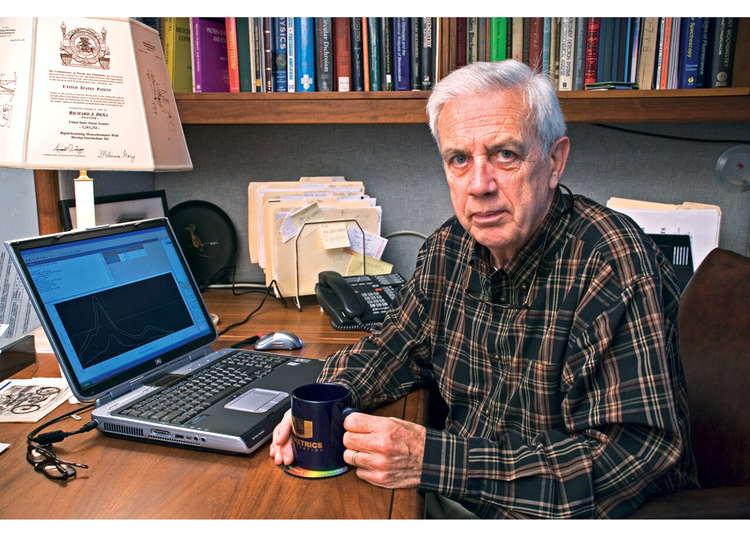Facts About Uv/vis Uncovered
Table of ContentsThe Best Strategy To Use For Uv/visThe smart Trick of Circular Dichroism That Nobody is Talking AboutRumored Buzz on Circularly Polarized LuminescenceSome Known Facts About Spectrophotometers.What Does Uv/vis Do?

Although spectrophotometry is most frequently applied to ultraviolet, noticeable, and infrared radiation, contemporary spectrophotometers can question wide swaths of the electromagnetic spectrum, including x-ray, ultraviolet, visible, infrared, and/or microwave wavelengths. Spectrophotometry is a tool that hinges on the quantitative analysis of particles depending on how much light is taken in by colored substances.
A Biased View of Uv/vis/nir
A spectrophotometer is frequently utilized for the measurement of transmittance or reflectance of solutions, transparent or nontransparent solids, such as polished glass, or gases. Many biochemicals are colored, as in, they absorb visible light and for that reason can be measured by colorimetric treatments, even colorless biochemicals can typically be converted to colored substances appropriate for chromogenic color-forming responses to yield substances appropriate for colorimetric analysis.: 65 Nevertheless, they can likewise be designed to measure the diffusivity on any of the noted light ranges that generally cover around 2002500 nm utilizing different controls and calibrations.
An example of an experiment in which spectrophotometry is utilized is the determination of the equilibrium constant of an option. A certain chemical response within a service may take place in a forward and reverse direction, where reactants form items and items break down into reactants. At some time, this chemical response will reach a point of balance called a stability point.
The Buzz on Uv/vis
The quantity of light that travels through the solution is a sign of the concentration of certain chemicals that do not allow light to travel through. The absorption of light is due to the interaction of light with the electronic and vibrational modes of molecules. Each kind of molecule has an individual set of energy levels connected with the makeup of its chemical bonds and nuclei and therefore will take in light of particular wavelengths, or energies, resulting in unique spectral homes.
They are widely utilized in numerous markets consisting of semiconductors, laser and optical production, printing and forensic evaluation, as well as in labs for the study of chemical substances. Spectrophotometry is frequently utilized in measurements of enzyme activities, determinations of protein concentrations, decisions of enzymatic kinetic constants, and measurements of ligand binding reactions.: 65 Ultimately, a spectrophotometer is able to identify, depending on the control or calibration, what substances are present in a target and exactly how much through calculations of observed wavelengths.
Developed by Arnold O. Beckman in 1940 [], the spectrophotometer was developed with the aid of his colleagues at his business National Technical Laboratories established in 1935 which would end up being Beckman Instrument Business and eventually Beckman Coulter. This would come as an option to the formerly created spectrophotometers which were not able to take in the ultraviolet properly.
Circular Dichroism for Dummies
It would be discovered that this did not give satisfactory results, for that reason in Model B, there was a shift from a glass to a quartz prism which permitted better absorbance outcomes - circular dichroism (https://www.artstation.com/julieanndesalorenz1/profile). From there, Model C was born with an adjustment to the wavelength resolution which ended up having three systems of it produced
It was produced from 1941 to 1976 where the price for it in 1941 was US$723 (far-UV accessories were an alternative at additional cost). In the words of Nobel chemistry laureate Bruce Merrifield, it was "probably the most essential instrument ever established towards the development of bioscience." Once it ended up being discontinued in 1976, Hewlett-Packard developed the first commercially available diode-array spectrophotometer in 1979 referred to as the HP 8450A. It irradiates the sample with polychromatic light which the sample absorbs depending upon its homes. It is transmitted back by grating the photodiode variety which spots the wavelength region of the spectrum. Ever since, the creation and implementation of spectrophotometry devices has actually increased exceptionally and has turned into one of the most innovative instruments of our time.

All about Uv/vis/nir
Historically, my latest blog post spectrophotometers use a monochromator consisting of a diffraction grating to produce the analytical spectrum. The grating can either be movable or fixed. If a single detector, such as a photomultiplier tube or photodiode is utilized, the grating can be scanned step-by-step (scanning spectrophotometer) so that the detector can measure the light strength at each wavelength (which will correspond to each "action").
In such systems, the grating is fixed and the intensity of each wavelength of light is measured by a various detector in the range. Additionally, most modern-day mid-infrared spectrophotometers use a Fourier change method to acquire the spectral details - https://visual.ly/users/julieanndesalorenz30606/portfolio. This method is called Fourier change infrared spectroscopy. When making transmission measurements, the spectrophotometer quantitatively compares the fraction of light that travels through a recommendation service and a test solution, then digitally compares the strengths of the 2 signals and computes the percentage of transmission of the sample compared to the recommendation requirement.
